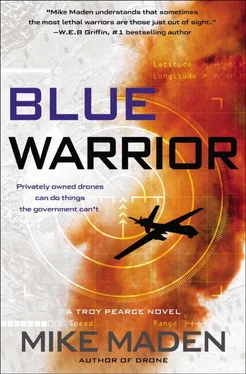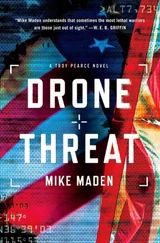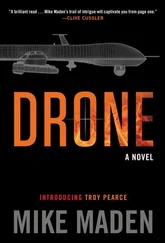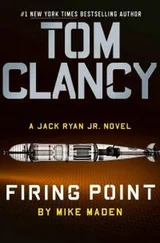“This won’t take long,” Mossa said. “You are welcome to remain in here and have some more tea.”
Pearce held out a hand. “After you.”
Mossa snatched up his automatic rifle and dashed through the low-ceilinged entrance, Pearce close behind and Early in the rear. They had all helped themselves to ammo and hand grenade stores in the caves. For the first time since he had arrived in Mali, Pearce felt ready to go.
Mossa led them to a covered lookout nestled in tall stones and pointed out the battlefield, then the sky. Vultures circled overhead in the early-morning light. He pointed them out. “They always know, even before the first shots.” Three lines of black Malian soldiers in camo threaded their way up the hill behind three BTRs just like the one back in Anou, each line about a hundred yards apart. They met no resistance.
The southernmost APC was the first to broach the deep trench, taking a steep angle of attack to minimize the downward slope. When the front wheels crested the far end of the trench, the nose of the vehicle pointed nearly skyward, like a whale breaching the surface of the ocean.
Shhhhttt—BOOM! An RPG slammed into the bottom deck of the personnel carrier, easily penetrating the thin armor. The vehicle erupted in flames. Even up here, Pearce could hear the screams. The soldiers who followed too closely behind were killed by the explosion or burned, too, and the others farther back driven away from the intense heat. A few still had their wits and fired in the direction of the RPG smoke trail. The other two columns fired wildly at the rocks in front of them, too, hoping to hit something.
The big 14.5mm machines guns on the surviving BTRs opened fire. They stopped short of the trench line, waiting for their accompanying troops to clear the way of other RPG teams hiding up ahead. Officers and sergeants shouted at the cowering troops, who finally pressed on, pushing through the trench first, then up into the steeper inclines, throwing grenades, firing rifles.
Meeting no resistance, they advanced more confidently up the hill, but the BTRs stayed put, offering covering fire with their heavy weapons.
Mossa let the soldiers climb farther up the hill. Towering piles of granite and basketball-sized stones broke up the neat columns, and the geologic formation of the mountain face gradually funneled the Malians into a centralized mass in the middle.
When they reached the halfway mark, Mossa called in to Balla and Moctar on his radio as he activated a remote-control switch.
The ridgeline opened up in a volley of machine-gun fire, tearing into the front rank of troops, dropping them. The others hit the deck or stepped back.
The ground erupted behind them as an electronically activated land mine exploded, mowing down a half-dozen men in the rear. The mass of soldiers instinctively surged forward. Another explosion tore into the squad in front.
They were trapped.
Panicked shouts as bullets tore into their ranks. The big diesels on the BTRs roared to life, belching smoke as drivers threw them into reverse.
A Mali soldier jumped up and ran back down the hill with long, determined strides, bullets spanging on the rocks around him. Miraculously, he didn’t hit a mine. Another soldier leaped up without his rifle and followed suit, but bullets stitched across his back and he tumbled into the sand, triggering an explosion.
Mindless panic erupted as the soldiers leaped up and scattered, mines exploding, bullets flying. One by one they dropped as they fled, or were ripped apart by the explosions at their feet. Shards of granite swept their ranks like shrapnel.
Mossa watched the carnage unfold, emotionless. Like killing a goat for supper.
CRACK! A bullet exploded against the rock just above his head.
Pearce knocked the Tuareg down and covered him with his body.
“Where?” Pearce asked Early.
“Eight o’clock, about five hundred yards up on the ledge.” Early hunkered down behind a boulder, signaling the direction with a stab of his finger.
“You all right?” Pearce asked Mossa.
“Still alive.”
Now Tuareg mortars opened up. Sand geysered on either side of the fleeing BTRs. Gunfire raked the sand and rocks around the few remaining soldiers still able to run, fleeing for their lives. Corpses littered the mountainside along with the wounded.
Another sniper round smashed into the stone above their heads. They were out of his sights now, but he was still on the hunt, hoping for a random strike.
Malian soldiers down the hill who had found enough cover feebly fired back up at the rocks. Enough fire, though, to keep everyone’s head down.
Pearce had only one 40mm grenade for the M4 in his hand, but it had only a four-hundred-meter range. And there was no way he was going to get into a pissing match with a trained sniper, swapping five-hundred-yard shots with a gun ill-suited for the purpose.
“Sit tight,” Pearce told Early, then dashed back into the cave where he’d spent the night. A minute later, he emerged with the unopened Pelican case he’d been hauling around since he’d arrived in Anou. He popped open the lid.
More rounds cracked into the rocks above Early and Mossa.
“What new toy do you have now?” Mossa called out.
Pearce uncrated an electrically powered Hybrid Quadrotor, modified for the South African Recces. With four rotors for vertical lift and one for pushing like a plane propeller, the HQ didn’t need a runway. Pearce pulled out the controller tablet and hit the auto-launch button. The vertical rotors fired up, kicking up sand like a leaf blower, blasting the drone into the sky. It hit the preprogrammed altitude of five hundred feet in seconds. The onboard camera automatically activated and streamed a live image onto the controller tablet. Pearce quickly found the sniper on the ridge and tapped his image. A red box overlay indicated that the target had been acquired.
“Here goes nothing,” Pearce muttered, and tapped the strike button.
The HQ didn’t hesitate. It raced another thousand feet higher, paused at the apex, then dove headlong toward the clueless sniper, exploding on impact. Five pounds of ultra-high-explosive material vaporized the shooter. The “suicide” drone had worked perfectly.
Pearce scooted back over to Mossa and Early. “All clear, but keep covered up. There might be another one.”
“Not likely,” Mossa said. “Look.”
The three men surveyed the battlefield. The two BTRs were long gone, while the third still roared with flames, black smoke boiling into the morning sky. The few survivors on the mountainside were badly wounded, clutching their guts, moaning, bleeding, dying.
Another goddamned killing floor, Pearce thought, and there he stood in the middle of it. Again.
Pearce glanced up into the sky. Those birds circling high up on the thermals had seen it all before, too. Thrived on it. He’d seen them everywhere he’d ever been in a fight. Maybe they were following him, like gulls after a fishing boat.
Pearce had no idea how right he was.
 38
38 
Adrar des Ifoghas
Kidal Region, Northeastern Mali
9 May
What Pearce failed to notice was that not all of those birds circling overhead were the same.
One of them belonged to Guo. It was a hawk drone, covered in lifelike plastic feathers. An amazing example of bio-mimicry at its best. The hawk drone’s high-resolution cameras had captured the entire battle, as well as the men who had fought it. The Tuaregs, of course, had their faces covered by their distinctive indigo tagelmust s, but the hawk’s cameras had captured parts of the faces of two guılao s. The images were being fed into JANUS, DARPA’s latest facial-recognition software, recently stolen from the Americans. JANUS focused on facial and skull morphology—pieces of faces, or faces contorted by smiles, shadows, frowns, et cetera—rather than on perfect full-face captures. It took only a few moments for the software in Weng’s computer to identify Troy Pearce and Mike Early.
Читать дальше

 38
38 











